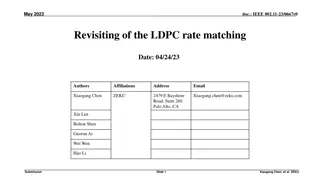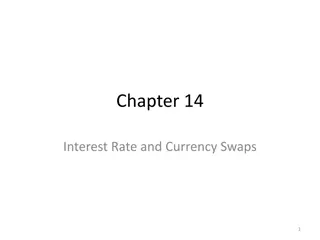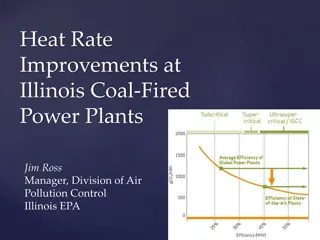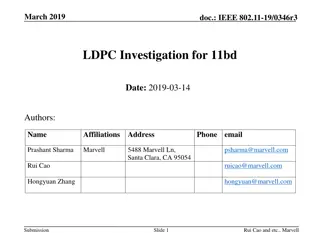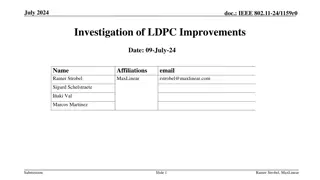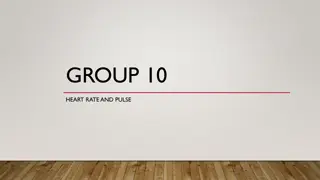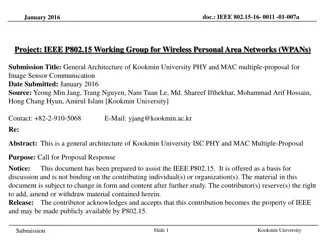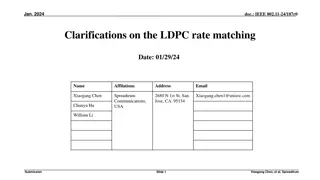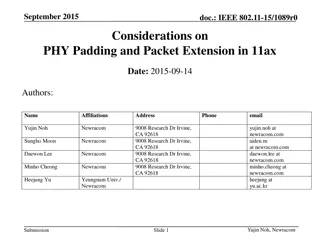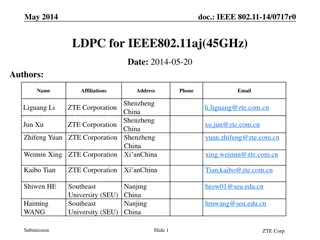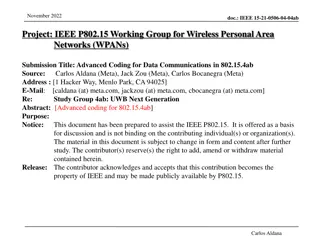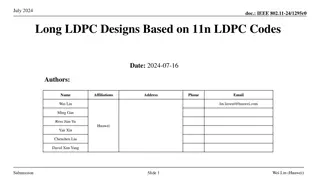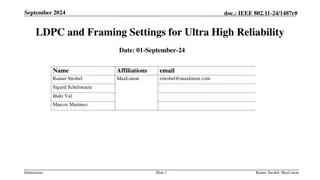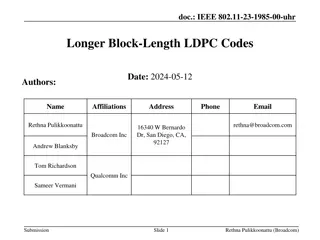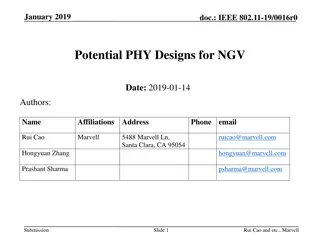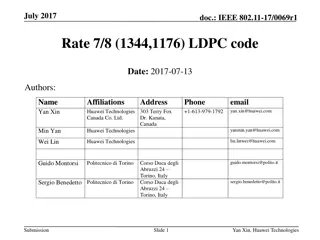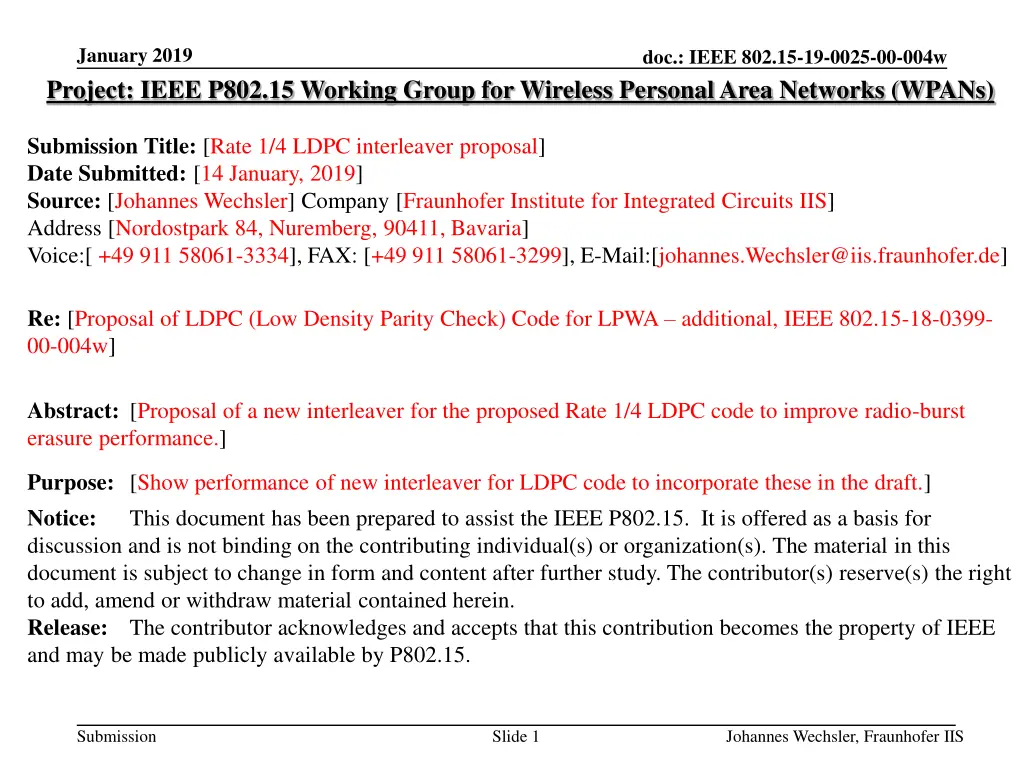
Improving LDPC Code Performance with New Interleaver
A proposal for a new interleaver to enhance the performance of the Rate 1/4 LDPC code in radio-burst scenarios. The document discusses the benefits of incorporating this new interleaver in the draft to achieve better radio-burst erasure performance. The proposal aims to address challenges related to channel estimation difficulties and low SNR conditions, ultimately leading to improved FEC performance.
Download Presentation

Please find below an Image/Link to download the presentation.
The content on the website is provided AS IS for your information and personal use only. It may not be sold, licensed, or shared on other websites without obtaining consent from the author. If you encounter any issues during the download, it is possible that the publisher has removed the file from their server.
You are allowed to download the files provided on this website for personal or commercial use, subject to the condition that they are used lawfully. All files are the property of their respective owners.
The content on the website is provided AS IS for your information and personal use only. It may not be sold, licensed, or shared on other websites without obtaining consent from the author.
E N D
Presentation Transcript
January 2019 Project: IEEE P802.15 Working Group for Wireless Personal Area Networks (WPANs) doc.: IEEE 802.15-19-0025-00-004w Submission Title: [Rate 1/4 LDPC interleaver proposal] Date Submitted: [14 January, 2019] Source: [Johannes Wechsler] Company [Fraunhofer Institute for Integrated Circuits IIS] Address [Nordostpark 84, Nuremberg, 90411, Bavaria] Voice:[ +49 911 58061-3334], FAX: [+49 911 58061-3299], E-Mail:[johannes.Wechsler@iis.fraunhofer.de] Re: [Proposal of LDPC (Low Density Parity Check) Code for LPWA additional, IEEE 802.15-18-0399- 00-004w] Abstract: [Proposal of a new interleaver for the proposed Rate 1/4 LDPC code to improve radio-burst erasure performance.] Purpose: [Show performance of new interleaver for LDPC code to incorporate these in the draft.] Notice: This document has been prepared to assist the IEEE P802.15. It is offered as a basis for discussion and is not binding on the contributing individual(s) or organization(s). The material in this document is subject to change in form and content after further study. The contributor(s) reserve(s) the right to add, amend or withdraw material contained herein. Release: The contributor acknowledges and accepts that this contribution becomes the property of IEEE and may be made publicly available by P802.15. Submission Slide 1 Johannes Wechsler, Fraunhofer IIS
January 2019 doc.: IEEE 802.15-19-0025-00-004w Rate 1/4 LDPC interleaver proposal Johannes Wechsler Fraunhofer IIS Submission Slide 2 Johannes Wechsler, Fraunhofer IIS
January 2019 doc.: IEEE 802.15-19-0025-00-004w Outline Iterative Decoding Current Interleaver Proposal for new interleaver for Rate 1/4 LDPC Simulation results Submission Slide 3 Johannes Wechsler, Fraunhofer IIS
January 2019 doc.: IEEE 802.15-19-0025-00-004w Iterative Decoding Performance degradation at low SNR due to short SHR Channel estimation difficult with little known symbols Low symbol rates of LPWA won t allow quasi static channels over the complete packet due to the long on air time Iterative decoding Allow partially decoding of the first bits after the SHR Use these bits to run another round of channel estimation Run the iteration multiple times until decoding is complete Improve FEC performance due to better LLR estimation at low SNR Submission Slide 4 Johannes Wechsler, Fraunhofer IIS
January 2019 doc.: IEEE 802.15-19-0025-00-004w Current circularly shifted block interleaver proposed for all FEC sub-packet 2 sub-packet 3 sub-packet 1 sub-packet J-1 sub-packet 4 sub-packet J p0 p0 p0 p0 p0 p0 p1 p1 p1 p1 p1 p1 SHR pM-2 pM-2 pM-2 pM-2 pM-2 pM-2 pM-1 pM-1 pM-1 pM-1 pM-1 pM-1 c0 c1 c2 c3 cJ-2 cJ-1 c2J-1 cJ cJ+1 cJ+2 c2J-3 c2J-2 c3J-2 c3J-1 c2J c2J+1 c3J-4 c3J-3 c4J-3 c4J-2 c4J-1 c3J c4J-5 c4J-4 cIJ-2 cIJ-1 c(I-1)J+1 c(I-1)J+2 cIJ-4 cIJ-3 Submission Slide 5 Johannes Wechsler, Fraunhofer IIS
January 2019 doc.: IEEE 802.15-19-0025-00-004w LDPC Code in detail 736 variable nodes: 552 check nodes: Submission Slide 6 Johannes Wechsler, Fraunhofer IIS
January 2019 doc.: IEEE 802.15-19-0025-00-004w LDPC Structure First k = 184 bits represent systematic part Connection from variable to check nodes random Remaining 3 * k = 552 bit represent redundancy Connection from variable to check nodes in staircase structure Iterative decoding of LDPC not possible with current interleaver First check nodes don t necessarily get information from the first bits after the SHR Staircase will allow iterative decoding, as they introduce a step-by- step structure Submission Slide 7 Johannes Wechsler, Fraunhofer IIS
January 2019 doc.: IEEE 802.15-19-0025-00-004w Proposed Hybrid Interleaver Submission Slide 8 Johannes Wechsler, Fraunhofer IIS
January 2019 doc.: IEEE 802.15-19-0025-00-004w Proposed Hybrid Interleaver 1. 2. 3. Split codeword in 4 chunks Bring 184 staircase variable node bits of chunk one to the front Spread these bits in a block interleaver fashion in pairs of two over the radio-bursts 1. Bit 0,1 go to burst 0 2. Bit 2,3 go to burst 1 3. Combine remaining variable node bits to one block Pseudo randomly scramble this block Fill remaining bits of the radio bursts with these bits 1. Bit 0,1 23 of the scrambled block go to burst 0 2. Bit 24,25, ,47 of the scrambled block go to burst 1 3. Slide 9 4. 5. 6. Submission Johannes Wechsler, Fraunhofer IIS
January 2019 doc.: IEEE 802.15-19-0025-00-004w Performance Comparison 0 erased radio-bursts Submission Slide 10 Johannes Wechsler, Fraunhofer IIS
January 2019 doc.: IEEE 802.15-19-0025-00-004w Performance Comparison 1 erased radio-bursts Submission Slide 11 Johannes Wechsler, Fraunhofer IIS
January 2019 doc.: IEEE 802.15-19-0025-00-004w Performance Comparison 2 erased radio-bursts Submission Slide 12 Johannes Wechsler, Fraunhofer IIS
January 2019 doc.: IEEE 802.15-19-0025-00-004w Performance Comparison 4 erased radio-bursts Submission Slide 13 Johannes Wechsler, Fraunhofer IIS
January 2019 doc.: IEEE 802.15-19-0025-00-004w Performance Comparison 8 erased radio-bursts Submission Slide 14 Johannes Wechsler, Fraunhofer IIS
January 2019 doc.: IEEE 802.15-19-0025-00-004w Performance Comparison 10 erased radio-bursts Submission Slide 15 Johannes Wechsler, Fraunhofer IIS
January 2019 doc.: IEEE 802.15-19-0025-00-004w Performance Comparison 12 erased radio-bursts Submission Slide 16 Johannes Wechsler, Fraunhofer IIS
January 2019 doc.: IEEE 802.15-19-0025-00-004w Performance Comparison 14 erased radio-bursts Submission Slide 17 Johannes Wechsler, Fraunhofer IIS
January 2019 doc.: IEEE 802.15-19-0025-00-004w Performance Comparison 15 erased radio-bursts Submission Slide 18 Johannes Wechsler, Fraunhofer IIS
January 2019 doc.: IEEE 802.15-19-0025-00-004w Performance Comparison 16 erased radio-bursts Submission Slide 19 Johannes Wechsler, Fraunhofer IIS
January 2019 doc.: IEEE 802.15-19-0025-00-004w Conclusion Performance of proposed interleaver beats current block interleaver for LDPC codes ~1dB gain when 15 radio-bursts are erased Allows for iterative decoding schemes for LDPC FEC Submission Slide 20 Johannes Wechsler, Fraunhofer IIS
January 2019 doc.: IEEE 802.15-19-0025-00-004w Thank you! Any questions or suggestions? Submission Slide 21 Johannes Wechsler, Fraunhofer IIS

